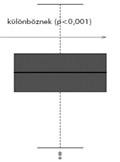The eLitMed.hu medical portal uses computer cookies for convenient operation. Detailed information can be found in the Cookie-policy.
Clinical Neuroscience - 2010;63(11-12)
Content
[Special concerns in medical care of severely demented patients suffering from Alzheimer disease]
[While the expected life-time increases dementias will show a pandemic nature. Author analyses the special medical and social concerns of severe states of Alzheimer disease. Having introduced the epidemiologic, diagnostic data and forms of palliatíve therapies he concentrates on the hitherto unsolved problems of patients and caregivers. He belongs to the experts identifying the Alzheimer diseases as a forced aging process. Accepted the theory of L. Hayflick he evaluates the aging process in frame of an evolution model. He states that for aged human beings having already performed the task of reproduction further conditions of living circumstances and even that of death are no more programmed. This hypothesis may have a very negative content at the first sense. But the author rather considers the uncertainty of aging a positive message. He establishes that the occurrence of degenerative processes connecting the aging must be limited by preventive interventions far more efficient than the present possibilities. Concerning these steps we are still on the level of recommendations for preserving our general health and data of relevant science are quite contradictory. Although criteria of “healthy", “qualified” or “assumable” aging are getting defined, we still do not know exactly how we should live optimally and what should we do for this in different epochs of our life. Somatic and psychological parameters are lacking which would be able to signalize the actual level of the aging process in a given person. We, physicians, also do not have exact opinion on the level of severity of dementias at which the patient already lost his her features of personality and individuality on an irreversible way. We have no idea on the phase when the ratio of joy and suffer falls below the value of 1.0 because we still have no tool for its measure. The author pointed the necessity of acceptance of a new preventive attitude and application of new methods in the medical care of the forced or pathological aging, instead of the present approaches based on the “wait and treat” attitude. Because of the intensive increase of the patient population the identification and care of patients can be efficient with a much more involvement of the basic medical network. Financial background can be improved by new theoretical bases of criteria of the palliative treatments. But the direct professional programs can be planned after solution of the existing moral and social dilemmas.]
[The concept of epileptic networks. Part 2.]
[In this paper we investigate evidences supporting the network concept of epilepsies from different approaches. Firstly the functions of cortical networks in which most of the epileptic networks are embedded, are treated. Then the tentative characteristics of an epileptic network are enumerated and the conversion mechanisms from physiological to epileptic networks are analyzed. Later the role of neuronal oscillations in epileptic networks and aspects of epilepsies provoked by sensory and cognitive tasks is studied. Lastly new fMRI data in mapping BOLD networks underlying spike and seizure discharges are used as arguments in favour of the epileptic network hypothesis. In a second part the well-known epilepsies related, or probably related to physiological networks are shown. Finally consequences of the network approach for creating a new unified epilepsy classification are discussed.]
[Evaluation of general well-being in adults with therapy resistant partial epilepsy taking oxcarbazepine]
[Aims - An open label, national, multicenter, observational study had been conducted to evaluate of psychological general well-being in adults with therapy resistant partial epilepsy taking oxcarbazepine in Hungary. The possibility was examined to differentiate the improvement of the psychic well-being caused by the better status of the seizure disorder or caused by the psychopharmacological effect of the oxcarbazepine (in the next: OXC). Methods - 528 patients were asked to fill the Hungarian validated version of Psychological General Well-Being Schedule (PGWB), English version created by Harold J. Dupuy in 1984, at the baseline visit and after 12- week long duration OXC therapy regim. Finally the data of 332 patients could be evaluated per protocol, biostatistical analysis was carried out. Results - Based on data of 332 patients (per protocol population) the OXC treatment significantly (p<0.0001) improved all items of PGWB in clinically well- controlled (responder) epileptic patients and improved affective markers of patients with uncontrolled epilepsy also. In case of patients suffering from uncontrolled epilepsy the increase of psychical wellbeing items score influenced by biological effects were higher than those influenced by external effects. Conclusions - It can be stated that the adopted PGWB test battery is reliable quantitative method to examine the psychological well-being of patients suffering from partial epilepsy. It was observed that OXC has significant psychopharmalogical effect besides the well-known anticonvulsive property among large Hungarian population of partial epileptic patiens. In case of OXC therapy the positive psychic effect of the successful anticonvulsive treatment and the stabilization property on the affectivity of epileptic patients significantly separates. The OXC has no indication for the treatment of psychiatric conditions.]
[Importance of hydrocephalus following severe brain injury during postacute rehabilitation]
[Objectives - We report our experiences with hydrocephalus in early rehabilitation over a seven-year period. Method - Retrospective study in Brain Injury Rehabilitation Unit of the National Institute for Medical Rehabilitation, between 1 January 2002 and 31 December 2008. Results - At our institute in the last seven years, we treated 83 patients with secondary and six patients with primary hydrocephalus. The majority of hydrocephalus was of post traumatic origin (52) and remaining 23 following stroke (SAH, AVM, ICH) or brain operation (tumour - seven, and one cranioplasty), and all these patients had undergone ventricular shunt implantation. Mean age of patients was 36 (14-80) years. Hydrocephalus was diagnosed in our rehabilitation unit in 20 of 83 cases and the other patients were shunted before transfer to our unit. The median time point of shunting was 70 (range: 20-270) days after trauma, brain surgery or stroke. Post-operative complications were seen in 12 of 89 patients: six infections and six shunt failure and revision was necessary in 14%. In PTH cases, the post-operative improvement was seen in 40 of 52 patients being shunted and corresponded to FIM scores. At the other 31 cases, with non-traumatic origin, only two patients remain unchanged. Conclusions - Hydrocephalus is considered to be a frequent and important complication after severe brain damage. The incidence of hydrocephalus treated with shunt implantation in our neuro-rehabilitation unit was 4.4%. The postoperative improvement was 77%. Posttraumatic hydrocephalus concerns 5.2% of patients with severe TBI during last seven years in our institution. Diagnosis of posttraumatic hydrocephalus was established in 24%, and complication after shunt implantation (14%) was also recognized in the post-acute rehabilitation unit. It is strongly recommended for the team working at such type of units to obtain clinical practice. Teamwork, good cooperation between acute and postacutecare is necessary for successful rehabilitation of these patients.]
[Account on the scientific meeting of Környey Society in 2010. Part 2.]
[Account on the scientific meeting of Környey Society in 2010. Part 2. 2010;63(11-12)]
[Classical neurology: Adieu! Or: what is the future of hungarian neurology, fruitful transformation or preprogrammed death?]
[According to our oppinion several ideas, trends and aims of the traditional neurology became outworn. (So together with all the romantic beauty and hierarchic relations: Adieu!). The specialisation within the main body of the profession is unavoidable. A new, high quality, cost-benefit sensitive, institutional system should be built up, non essentially on inpatient, but on outpatient basis, supported by a personal and partnership oriented patient/doctor relationship, with multidiszciplinatory co-operations and team-work. Education should be also rebuilt accordingly. This analysis of the present situation and recommendations for the future plans was given - since our ages - without any personal interest or attraction. We tried to keep before us only the future of our beloved profession, the preservation of worths, and the exploration of the withdrawing dogmatic views. We invite everybody who is interested in the current questions of our profession to share their oppinion with the whole neurological society and take part in open discussion of these important questions.]
[Account on the events of XIXth Symposium Neuroradiologicum]
[Account on the events of XIXth Symposium Neuroradiologicum 2010;63(11-12)]
1.
Clinical Neuroscience
[Headache registry in Szeged: Experiences regarding to migraine patients]2.
Clinical Neuroscience
[The new target population of stroke awareness campaign: Kindergarten students ]3.
Clinical Neuroscience
Is there any difference in mortality rates of atrial fibrillation detected before or after ischemic stroke?4.
Clinical Neuroscience
Factors influencing the level of stigma in Parkinson’s disease in western Turkey5.
Clinical Neuroscience
[The effects of demographic and clinical factors on the severity of poststroke aphasia]1.
2.
Clinical Oncology
[Pancreatic cancer: ESMO Clinical Practice Guideline for diagnosis, treatment and follow-up]3.
Clinical Oncology
[Pharmacovigilance landscape – Lessons from the past and opportunities for future]4.
5.











